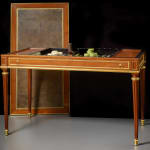Jean-François Leleu
Literature
Pierre Kjellberg, "Le Mobilier Français du XVIIIe Siècle", 1998, p. 515, illustrating a Louis XVI bureau plat by Leleu of similar design. And p. 517, pl. C, illustrating a comparable tric trac table by the same maker.
A magnificent Louis XVI gilt bronze mounted mahogany tric trac games table by Jean-François Leleu stamped on the top of one of the side drawers J. F. Leleu, the oak carcass mahogany table with a green tooled leather inset top with gilt brass gallery above a long frieze dummy drawer with foliate gilt bronze banding and ring handles at each end, concealing at the front a small drawer on the far right hand side and on the correspondingly arranged back, a drawer on the far left hand side, the back and front frieze with a rectangular gilt bronze banded panel to either end and gilt bronze banding to both sides. The top lifting off to reveal inside a backgammon playing board made of various coloured woods complete with the original bone counters and the original circular brown leather dice shakers, with a shallow well to either side of the central deeper well, the whole on turned tapering fluted legs headed by gilt bronze bands, on turned toupie feet and gilt bronze sabots
Paris, date circa 1785
Height 120 cm, length 75 cm, depth 60 cm.
Born in Paris, Jean-François Leleu (1729-1807) was well prepared for a brilliant career when he served his apprenticed in the workshop of Jean-François Oeben (1721-63) at the Arsenal. While there he learned his craft and as F.J.B. Watson notes in "Louis XVI Furniture", 1973, p. 70 "if the table à transformations in the Wallace Collection which bears his name crudely cut into the carcase is really entirely his own, made when he was still a mere compagnon (and therefore precluded from signing his furniture), he was evidently a highly skilled craftsman already." When Oeben died in 1763, Leleu, then aged thirty-four, hoped to take over the workshop, but he was superseded by his slightly younger colleague and fellow worker, Jean-Henri Riesener (1734-1806), who in 1767 married Oeben's widow.
In September 1764 Leleu was received as a maître ébéniste but even this did not prevent his ongoing rivalry with Riesener, who the following year found it necessary to summon Leleu for assault. Leleu's jealousy and disappointment was probably exacerbated by Riesener's Germanic origin since, he like other native French members of the furniture-making guild, strongly resented the influx of foreign craftsmen, especially Germans, into the Paris guild system. Seeing no future in the Riesener workshop, Leleu left in 1764 and quickly established himself on his own in the rue Royale, near the Place des Vosges. It was there that he soon achieved great success and counted Louis XV, the king's mistress Madame du Barry and the Prince de Condé among his clients in addition to the Parisian marchands-merciers. Between 1772 and 1777 Leleu supplied the Prince de Condé with furniture costing more than 60,000 livres for his Paris residences the Palais Bourbon as well as the Hôtel de Lassay and the Châteaux de Chantilly and Saint-Maur. Work for Madame de Barry included some exceedingly fine porcelain mounted furniture for her residence at Louveciennes. Presumably this was ordered from him by the marchand Poirier who had a near monopoly of Sèvres porcelain made for this purpose and whose bills to Madame du Barry were extremely costly during the period that Louveciennes was being furnished.
Leleu worked in both the Transitional Louis XV/Louis XVI styles as well as the full Louis XVI style as we see here in the refined and restrained Neo-classical lines of this elegant tric trac table. Its high quality construction, with intricate mechanical fittings were one of the many techniques he learned from Oeben. Other of Leleu's pieces feature intricate marquetry work with both pictorial and geometric patterns, so often offset by refined gilt bronze mounts. In addition to tric trac tables, bureaux, secrétaires and bonheurs-du-jour, Leleu made exceedingly fine commodes, encoigneurs, carved fauteuils and on occasion cases for longcase clocks and regulators, one of which houses a movement by Lepaute.
As a reflection of his standing, works by Leleu can now be found in many of the world's finest collections including the Musée de Louvre, the Musée des Arts Décoratifs and Musée de Nissim-de-Camondo in Paris. Further examples can be found at Château de Versailles, the Wallace Collection London as well as the Metropolitan Museum in New York, Cleveland Museum of Art, Ohio, the Huntingdon Collection in San Marino, the Rijksmuseum in Amsterdam as well as two attributed pieces in the J. Paul Getty Museum California.



